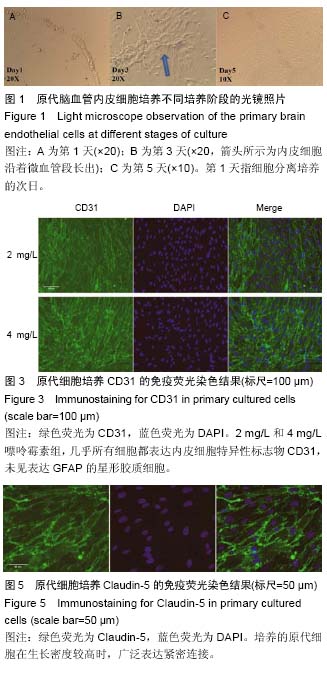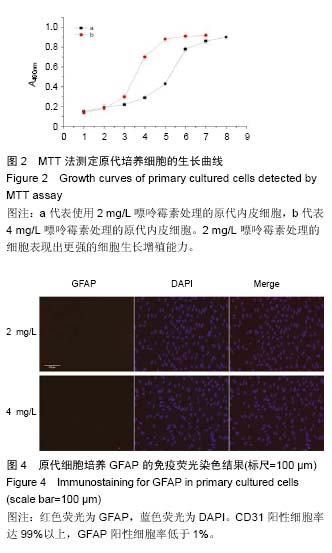| [1] Mehrotra D,Wu J, Papangeli I, et al.Endothelium as a gatekeeper of fatty acid transport. Trends Endocrinol Metab.2014; 25(2):99-106.[2] Sonveaux P,Copetti T,De Saedeleer CJ,et al.Targeting the lactate transporter MCT1 in endothelial cells inhibits lactate-induced HIF-1 activation and tumor angiogenesis.PLoS One.2012;7(3):e33418.[3] Upadhyay RK. Transendothelial Transport and Its Role in Therapeutics. Int Sch Res Notices.2014; 2014:309404.[4] Fukuhara S,Mochizuki N. [Lymphocytes mobilization into blood regulated by Spns2, a sphingosine 1-phosphate transporter, expressed on endothelial cells]. Seikagaku.2013; 85(4):269-272.[5] Deng D, Xu C, Sun P, et al. Crystal structure of the human glucose transporter GLUT1. Nature. 2014; 510(7503):121-125.[6] Soliman A, Ayele BT ,Daayf F.Biochemical and molecular characterization of barley plastidial ADP-glucose transporter (HvBT1). PLoS One.2014; 9(6):e98524.[7] Dogrukol-Ak D, Kumar VB, Ryerse JS, et al.Isolation of peptide transport system-6 from brain endothelial cells: therapeutic effects with antisense inhibition in Alzheimer and stroke models. J Cereb Blood Flow Metab.2009; 29(2):411-422.[8] Lindner C, Sigruner A, Walther F, et al. ATP-binding cassette transporters in immortalised human brain microvascular endothelial cells in normal and hypoxic conditions.Exp Transl Stroke Med.2012; 4(1):9.[9] Roy U, Bulot C,Honer zu Bentrup K, et al.Specific increase in MDR1 mediated drug-efflux in human brain endothelial cells following co-exposure to HIV-1 and saquinavir. PLoS One.2013; 8(10):e75374.[10] Chiu C, Miller M C, Monahan R, et al. P-glycoprotein expression and amyloid accumulation in human aging and Alzheimer's disease: preliminary observations. Neurobiol Aging. 2015; 36(9):2475-2482.[11] Jeynes B,Provias J.P-Glycoprotein Altered Expression in Alzheimer's Disease: Regional Anatomic Variability. J Neurodegener Dis.2013;2013:257953.[12] Vogelgesang S,Cascorbi I,Schroeder E,et al. Deposition of Alzheimer's beta-amyloid is inversely correlated with P-glycoprotein expression in the brains of elderly non-demented humans. Pharmacogenetics. 2002; 12(7):535-541.[13] Deo A K, Borson S, Link J M, et al. Activity of P-Glycoprotein, a beta-Amyloid Transporter at the Blood-Brain Barrier, Is Compromised in Patients with Mild Alzheimer Disease.J Nucl Med.2014;55(7): 1106-1111.[14] Kanekiyo T, Cirrito J R, Liu CC, et al. Neuronal clearance of amyloid-beta by endocytic receptor LRP1.J Neurosci.2013; 33(49):19276-19283.[15] Deane R, Bell R D, Sagare A, et al. Clearance of amyloid-beta peptide across the blood-brain barrier: implication for therapies in Alzheimer's disease. CNS Neurol Disord Drug Targets.2009; 8(1):16-30.[16] Kanekiyo T ,Bu G. The low-density lipoprotein receptor-related protein 1 and amyloid-beta clearance in Alzheimer's disease. Front Aging Neurosci. 2014; 6:93.[17] Gidal BE. P-glycoprotein Expression and Pharmacoresistant Epilepsy: Cause or Consequence? Epilepsy Curr.2014;14(3):136-138.[18] Robey RW, Lazarowski A,Bates SE.P-glycoprotein--a clinical target in drug-refractory epilepsy? Mol Pharmacol. 2008; 73(5):1343-1346.[19] Feldmann M, Asselin MC, Liu J, et al.P-glycoprotein expression and function in patients with temporal lobe epilepsy: a case-control study. Lancet Neurol. 2013; 12(8):777-785.[20] Wang GX, Wang DW, Liu Y, et al. Intractable epilepsy and the P-glycoprotein hypothesis. Int J Neurosci. 2016;126(5):385-392.[21] Nakahashi T,Fujimura H,Altar CA,et al.Vascular endothelial cells synthesize and secrete brain-derived neurotrophic factor. FEBS Lett.2000; 470(2):113-117.[22] Seki T,Hosaka K,Lim S,et al.Endothelial PDGF-CC regulates angiogenesis-dependent thermogenesis in beige fat.Nat Commun.2016; 7:12152.[23] da Silva RG, Tavora B, Robinson SD, et al. Endothelial alpha3beta1-integrin represses pathological angiogenesis and sustains endothelial-VEGF.Am J Pathol.2010; 177(3):1534-1548.[24] Wang C, Qin L, Manes TD, et al. Rapamycin antagonizes TNF induction of VCAM-1 on endothelial cells by inhibiting mTORC2. J Exp Med. 2014; 211(3): 395-404.[25] Schmitz B,Vischer P,Brand E,et al.Increased monocyte adhesion by endothelial expression of VCAM-1 missense variation in vitro. Atherosclerosis.2013; 230(2):185-190.[26] Paulis LE, Jacobs I, van den Akker NM, et al. Targeting of ICAM-1 on vascular endothelium under static and shear stress conditions using a liposomal Gd-based MRI contrast agent. J Nanobiotechnology.2012; 10:25.[27] Huang H,Jing G,Wang JJ,et al.ATF4 is a novel regulator of MCP-1 in microvascular endothelial cells. J Inflamm (Lond).2015; 12:31.[28] van Beijnum JR, Rousch M, Castermans K, et al. Isolation of endothelial cells from fresh tissues. Nat Protoc.2008; 3(6):1085-1091.[29] Navone SE, Marfia G, Invernici G, et al.Isolation and expansion of human and mouse brain microvascular endothelial cells. Nat Protoc.2013; 8(9):1680-1693.[30] Perriere N, Demeuse P, Garcia E, et al. Puromycin-based purification of rat brain capillary endothelial cell cultures. Effect on the expression of blood-brain barrier-specific properties. J Neurochem. 2005; 93(2):279-289.[31] Barrand MA, Robertson KJ ,von Weikersthal SF. Comparisons of P-glycoprotein expression in isolated rat brain microvessels and in primary cultures of endothelial cells derived from microvasculature of rat brain, epididymal fat pad and from aorta. FEBS Lett. 1995;374(2):179-183. |
.jpg) 文题释义:
人脑微血管内皮细胞:是血脑屏障的主要组成成分,能够限制可溶性物质和细胞等从血液进入大脑。大脑微血管内皮细胞与外周内皮细胞相比具有一些相同特性。
紧密连接:由分支状封闭索网络组成,每条封闭索独立于其他封闭索作用。因而,紧密连接防止离子通过的能力随封闭索的数目指数式增长。每条封闭索由一列嵌入两个原生质膜的跨膜蛋白构成,蛋白的胞外结构域使其彼此间一个个直接相联。尽管还有其他蛋白存在,两种主要类型的蛋白是密封蛋白和闭合蛋白,它们与位于细胞膜内侧的不同的把封闭索锚定到肌动蛋白细胞骨架的外周膜蛋白相联。因此,紧密连接连起了相邻细胞的细胞骨架。
文题释义:
人脑微血管内皮细胞:是血脑屏障的主要组成成分,能够限制可溶性物质和细胞等从血液进入大脑。大脑微血管内皮细胞与外周内皮细胞相比具有一些相同特性。
紧密连接:由分支状封闭索网络组成,每条封闭索独立于其他封闭索作用。因而,紧密连接防止离子通过的能力随封闭索的数目指数式增长。每条封闭索由一列嵌入两个原生质膜的跨膜蛋白构成,蛋白的胞外结构域使其彼此间一个个直接相联。尽管还有其他蛋白存在,两种主要类型的蛋白是密封蛋白和闭合蛋白,它们与位于细胞膜内侧的不同的把封闭索锚定到肌动蛋白细胞骨架的外周膜蛋白相联。因此,紧密连接连起了相邻细胞的细胞骨架。.jpg) 文题释义:
人脑微血管内皮细胞:是血脑屏障的主要组成成分,能够限制可溶性物质和细胞等从血液进入大脑。大脑微血管内皮细胞与外周内皮细胞相比具有一些相同特性。
紧密连接:由分支状封闭索网络组成,每条封闭索独立于其他封闭索作用。因而,紧密连接防止离子通过的能力随封闭索的数目指数式增长。每条封闭索由一列嵌入两个原生质膜的跨膜蛋白构成,蛋白的胞外结构域使其彼此间一个个直接相联。尽管还有其他蛋白存在,两种主要类型的蛋白是密封蛋白和闭合蛋白,它们与位于细胞膜内侧的不同的把封闭索锚定到肌动蛋白细胞骨架的外周膜蛋白相联。因此,紧密连接连起了相邻细胞的细胞骨架。
文题释义:
人脑微血管内皮细胞:是血脑屏障的主要组成成分,能够限制可溶性物质和细胞等从血液进入大脑。大脑微血管内皮细胞与外周内皮细胞相比具有一些相同特性。
紧密连接:由分支状封闭索网络组成,每条封闭索独立于其他封闭索作用。因而,紧密连接防止离子通过的能力随封闭索的数目指数式增长。每条封闭索由一列嵌入两个原生质膜的跨膜蛋白构成,蛋白的胞外结构域使其彼此间一个个直接相联。尽管还有其他蛋白存在,两种主要类型的蛋白是密封蛋白和闭合蛋白,它们与位于细胞膜内侧的不同的把封闭索锚定到肌动蛋白细胞骨架的外周膜蛋白相联。因此,紧密连接连起了相邻细胞的细胞骨架。

.jpg) 文题释义:
人脑微血管内皮细胞:是血脑屏障的主要组成成分,能够限制可溶性物质和细胞等从血液进入大脑。大脑微血管内皮细胞与外周内皮细胞相比具有一些相同特性。
紧密连接:由分支状封闭索网络组成,每条封闭索独立于其他封闭索作用。因而,紧密连接防止离子通过的能力随封闭索的数目指数式增长。每条封闭索由一列嵌入两个原生质膜的跨膜蛋白构成,蛋白的胞外结构域使其彼此间一个个直接相联。尽管还有其他蛋白存在,两种主要类型的蛋白是密封蛋白和闭合蛋白,它们与位于细胞膜内侧的不同的把封闭索锚定到肌动蛋白细胞骨架的外周膜蛋白相联。因此,紧密连接连起了相邻细胞的细胞骨架。
文题释义:
人脑微血管内皮细胞:是血脑屏障的主要组成成分,能够限制可溶性物质和细胞等从血液进入大脑。大脑微血管内皮细胞与外周内皮细胞相比具有一些相同特性。
紧密连接:由分支状封闭索网络组成,每条封闭索独立于其他封闭索作用。因而,紧密连接防止离子通过的能力随封闭索的数目指数式增长。每条封闭索由一列嵌入两个原生质膜的跨膜蛋白构成,蛋白的胞外结构域使其彼此间一个个直接相联。尽管还有其他蛋白存在,两种主要类型的蛋白是密封蛋白和闭合蛋白,它们与位于细胞膜内侧的不同的把封闭索锚定到肌动蛋白细胞骨架的外周膜蛋白相联。因此,紧密连接连起了相邻细胞的细胞骨架。